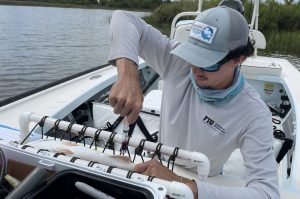|
Getting your Trinity Audio player ready...
|
 Pharmaceutical contaminants have been found in the blood and other tissues of redfish in Florida waters during a year-long study by FIU and Bonefish & Tarpon Trust (BTT).
Pharmaceutical contaminants have been found in the blood and other tissues of redfish in Florida waters during a year-long study by FIU and Bonefish & Tarpon Trust (BTT).

Cardiovascular medications, opioid pain relievers, and psychoactive medications were most commonly detected. The antiarrhythmic medication flecainide and the opioid pain reliever tramadol were detected in more than 50 percent of the redfish. The antipsychotic medication flupentixol was detected above safe levels in one in five of the redfish samples.
This research, which follows a similar study on bonefish in the Florida Keys that also revealed high levels of pharmaceutical contamination, shows these waterborne contaminants are a statewide concern. Similar to the results of the bonefish study, pharmaceuticals were found in all of the estuaries sampled, with an average of two drugs per fish and a maximum of five. Only seven out of the 113 sampled fish had zero drugs in their system. On average, 25.7 percent of the fish exceeded a level of pharmaceuticals considered safe, which equates to one-third of the therapeutic levels in humans.
“These studies of bonefish and redfish are the first to document the concerning presence of pharmaceuticals in species that are important to Florida’s recreational fisheries,” said Jennifer Rehage, FIU professor and the study’s lead researcher. “Given the impacts of many of these pharmaceuticals on other fish species and the types of pharmaceuticals found, we are concerned about the role pharmaceuticals play in the health of our fisheries. We will continue this work to get more answers to these concerning questions.”
Scientists and volunteer guides and anglers sampled redfish in nine of Florida’s most important estuaries: Pensacola, Apalachicola, Cedar Key, Tampa Bay, Charlotte Harbor, Florida Bay, Northern Indian River Lagoon, St. Augustine and Jacksonville.
“The results underscore the urgent need to modernize Florida’s wastewater treatment systems,” said BTT President and CEO Jim McDuffie. “Human-based contaminants like these pose a significant threat to Florida’s recreational fishery, which has an annual economic impact of $13.9 billion and directly supports more than 120,000 jobs.”
Approximately five billion prescriptions are filled each year in the U.S., yet there are no environmental regulations for the production or disposal of pharmaceuticals worldwide. Pharmaceutical contaminants originate most often from human wastewater and are not sufficiently removed by conventional water treatment. They remain active at low doses and can be released constantly, and exposure can affect all aspects of fish behavior, with negative consequences for their reproduction and survival. Pharmaceutical contaminants have been shown to affect all aspects of the life of fish, including their feeding, activity, sociability and migratory behavior.
“Florida is a leader in addressing water quality issues and wastewater infrastructure, including converting septic systems to sewage treatment,” said Kellie Ralston, BTT’s vice president for conservation and public policy. “The results of this study indicate that there are additional opportunities for improvement by retrofitting existing wastewater treatment plants with innovative technologies, like ozone treatment, to remove pharmaceuticals and requiring such technology on new wastewater facilities.”
Click Here to view a summary of Redfish Pharmaceutical Contaminants Study’s findings.





